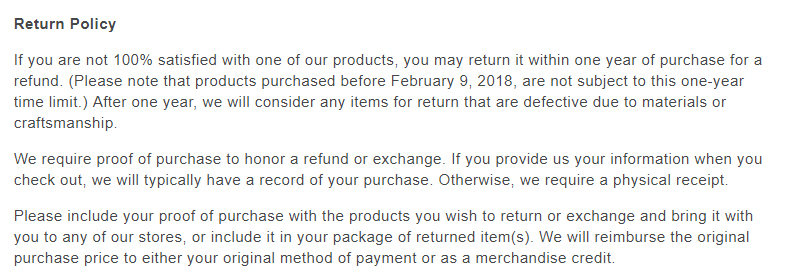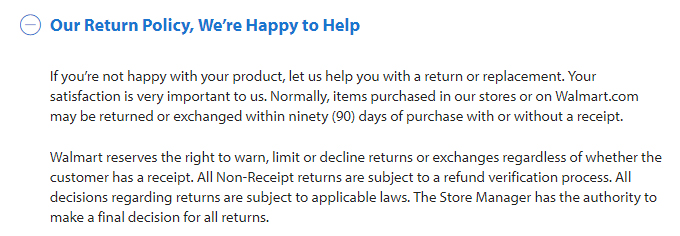Refund Disclaimers
What's your refund policy? Do you provide refunds within 30, 60, or 90 days? In the form of store credit only?
Whatever your policy is, you need a Refund Disclaimer. A Refund Disclaimer is a brief statement telling customers that whatever your policy is, you still retain the right to deny a refund to them. This has a number of business benefits, but the most important one may be that it allows you to deny fraudulent returns.
We've put together a guide to Refund Disclaimers, so you can write your own disclaimer to protect your profits and your business.
What's a Refund Disclaimer?
A Refund Disclaimer potentially supports you in denying a customer a refund.
The U.S. federal government doesn't mandate refunds or these disclaimers. However, individual states that you may operate in likely have their own laws for returns and refunds.
For example, any retailers in California that wish to have a "no full refund" policy in place must clearly display this policy to shoppers. If the policy isn't displayed, shoppers will automatically be given 30 days from the date of purchase to be legally allowed to return the item for a full refund with proof of purchase.
Even cities can mandate refund policies via civil code, which apply to both physical and online businesses registered within the city's jurisdiction.
New York City requires businesses to post a refund policy in clear view of the customer's eye line. If the business doesn't follow the rules, the customer has a right to a 30-day refund for unused items in the choice of cash or credit.
Even without a legal requirement, adding a Refund Disclaimer benefits your business because it limits your liability in the event of a customer dispute over your refusal of a refund.
Refund Policy vs. Refund Disclaimer
A Refund Policy outlines your business's entire refund process by laying out the terms and conditions upon which a customer may receive a refund, how the refund will be processed and other important details.
Policies are different from disclaimers because a disclaimer warns consumers that a service, namely a refund, may be withheld from the customer. A disclaimer effectively says that while you do have a Refund Policy, your company is within its rights not to provide that refund when and if it chooses.
A Refund Policy may include a Refund Disclaimer along with a lot of other refund-related information.
Your Refund Policy may be multiple pages long, while your Refund Disclaimer will likely be just a few sentences long at most.
When Should You Have a Refund Disclaimer?
Any time you're selling a product, whether physical or digital, you'll likely have some customers asking for a refund. You need to be able to say no to some refunds or you risk becoming a victim of return fraud.
Return fraud is a practice used by consumers to purchase products they have no intention of keeping and it ultimately costs US retailers over $10 billion every year.
Relaxed Return Policies lead customers to buy (or even steal) and then return products for cash or store credit. It happens so often that 95.2% of retailers experience it.
In fact, L.L. Bean changed its famous lifetime Return Policy to a more conservative one year limit to reduce the cost of fraud.
The family-owned outdoor retailer noted that not only does it experience the most common types of retail fraud, but the rate only accelerated with the rise of social media. People looking to commit return fraud would regularly share their stories and tips on Facebook and other platforms to teach others how to take advantage of L.L. Bean's founders generous promise.
Some customers were weary about the change, but with a standard and fair Return Policy put in its place, L.L. Bean made the transition a smooth one.
Here's LL Bean's new Return Policy:

Why Do You Need a Refund Disclaimer?
Adding a Refund Disclaimer to your website both warns your customers of the risks of purchasing products from your website and limits your liability if and when a customer asks for a refund and you deny it. In some cases, having one also helps you uphold the law.
But it does more than that: it provides transparency that bolsters customers' trust in your brand.
Your refund policies and disclaimers are more than legal documents. They're also part of your customer service efforts. When a customer has questions, you're able to point them to your policy for information. It prevents them from wondering whether your returns process is arbitrary and builds loyalty even through the returns process.
Not having a Refund Disclaimer leaves customers in the dark and may even cause them to leave your brand entirely.
Time Magazine told a story about a woman named Janine who used to shop at Williams Sonoma:
"...she walks by a once-favorite store, Williams Sonoma. Why? She wasn't able to return a gift without a gift receipt. Janine shops at lots of other stores that won't take returns without receipts, but Williams Sonoma is the only one that gets her cold shoulder. That's because for years Janine says she had "paid top dollar at Williams Sonoma," and she'd expected that due to her loyalty as a customer, as well as the amount of money charged by the store, the retailer would have a more flexible return policy."
A clear, fair disclaimer and Return Policy would have saved Williams Sonoma both Janine's loyalty and the loyalty of thousands of other shoppers like her.
Refunding Digital Products vs. Physical Products
Providing a refund for a physical product is fairly straightforward. We're all accustomed to the idea. The customer returns the physical product in exchange for cash or store credit.
The specifics of the return depend on the individual policy. Is it limited to only defective items? Or are unused and unwanted items also included? Is a receipt required? All these questions are answered according to what best suits your business and your customers.
Returning digital products is slightly trickier because in many cases digital products can't be returned.
As a result, some businesses choose not to issue refunds to customers after they have received or accessed the digital product.
Here's an example of Creative Strategies' policy on digital products:

If you allow refunds, you need to state specifically that those refunds are allowed and the conditions under which they are allowed. In Creative Strategies' case, refunds are only allowed if the product wasn't downloaded either because the customer didn't use it or the link, or if the download was faulty.
Ultimately, the decision comes down to what best suits your brand, customers, and product type. Whatever you choose, make sure to write a policy and apply it consistently.
How to Draft a Refund Disclaimer with Examples
A Refund Disclaimer should be placed at the very top of the Refund Policy so that customers are made plainly aware that returns are subject to conditions and terms.
There are several ways to draft a Refund Disclaimer. Most methods depend on the policy type. Thus, the first step to creating a disclaimer is to have a fully functional Refund Policy already in place.
We've put together a few examples.
At the top of Walmart's Return Policy, the company includes a very basic yet effective sentence: "Walmart reserves the right to warn, limit, or decline returns or exchanges regardless of whether the customer as a receipt."

This sentence should always be included, and Walmart has done it masterfully because it allows the company or any employee to deny any return based on the policy and puts that information out immediately to the customer.
Walmart also notes its policy that store managers make the final decision on all returns. The sentence prevents customers from perpetually attempting to escalate a refund complaint.
Walmart has a fairly detailed disclaimer in part because it is the retailer at hand and operates both e-commerce and brick and mortar stores. Amazon is in a different position because it is both the seller and the host for many other sellers.
Rather than providing a blanket disclaimer, Amazon writes a simple sentence to introduce its policy:

If you're selling a wide variety of products across many channels with different policies, this blanket approach may work for your because it is vague enough to cover everything but not so specific that it limits the ability of sellers to do business.
In essence, it says that Refund Policies vary according to those characteristics, so Amazon can't say whether you will or won't receive the refund you desire.
Barnes and Noble combines ecommerce and in-store purchases by allowing customers to buy online and return in-store. Its disclaimer reflects their purchase and return policy by not only saying that deviating from the policy may hold back a refund, but that they may even hold onto the item you returned.

The policy provides cover for Barnes and Noble by allowing them to deny refunds and returns when customers deviate from the carefully planned return policies.
Adding a refund disclaimer to your site draws together your Refund Policy and allows you to:
- Remain in control of the refund process as your business grows
- Limit refund fraud and save money
- Demonstrate transparency and build a strong bond with customers
Remember, applying your Refund Policy consistently is key to building up trust, but a Refund Disclaimer allows you to deviate from the policy where you see fit. The disclaimer shouldn't exist to encourage you to deny refunds but to back up your employees in the event that a refund needs to be rejected for legitimate reasons.